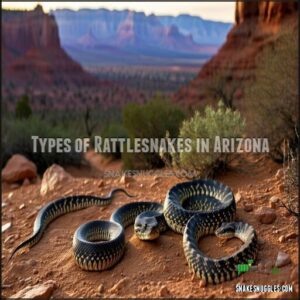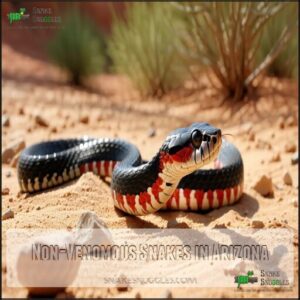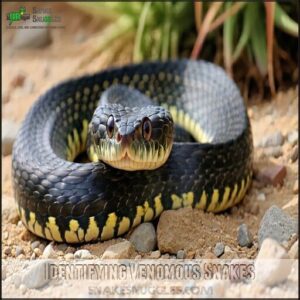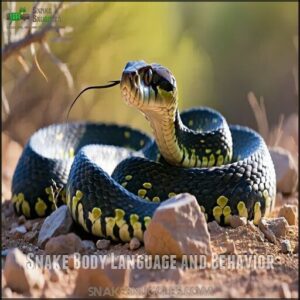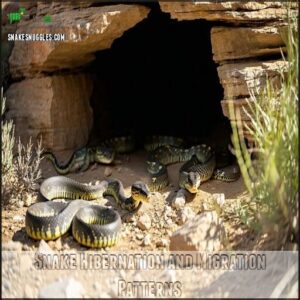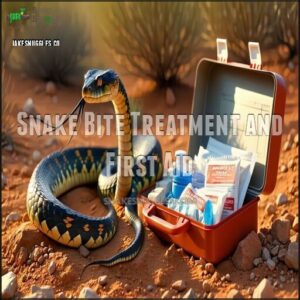This site is supported by our readers. We may earn a commission, at no cost to you, if you purchase through links.
 Arizona is home to over 20 species of venomous snakes, with rattlesnakes being the stars of the show.
Arizona is home to over 20 species of venomous snakes, with rattlesnakes being the stars of the show.
You’ll find the infamous western diamondback, known for its defensive attitude, and the Mojave rattlesnake, which has particularly potent venom. Other notable rattlesnakes include the black-tailed, sidewinder, and tiger rattlesnakes.
The small but striking Arizona coral snake also makes the list, sporting red, black, and yellow bands. These snakes typically prefer desert, rocky areas, or grassy plains, but they’ll avoid humans when possible.
It’s best to keep your distance and stay alert—Arizona’s snakes are fascinating, but you don’t want to get too close to these wild creatures.
Table Of Contents
- Key Takeaways
- Venomous Snakes in Arizona
- Rattlesnakes in Arizona
- Non-Venomous Snakes in Arizona
- Snake Safety and Prevention
- Other Venomous Creatures in Arizona
- Snake Identification and Behavior
- Snake Bite Treatment and First Aid
- Frequently Asked Questions (FAQs)
- What is the Best Way to Identify a Venomous Snake?
- Are There Any Venomous Snakes That Live in Urban Areas?
- What is the Best Way to Avoid Being Bitten by a Venomous Snake?
- Are There Any Venomous Snakes in Arizona That Are Endangered?
- What Are the Long-term Effects of a Venomous Snake Bite?
- What is the most poisonous snake in Arizona?
- What area of Arizona has the most rattlesnakes?
- Do we have copperheads in AZ?
- What is the deadliest creature in Arizona?
- Do we have copperheads in Arizona?
- Conclusion
Key Takeaways
- Arizona is home to 21 venomous snake species, including 13 types of rattlesnakes like the western diamondback and sidewinder, as well as the Arizona coral snake.
- Most venomous snakes in Arizona live in deserts, rocky areas, or grassy plains and try to avoid humans unless provoked.
- The Mojave rattlesnake, known for highly potent venom, is one of the most dangerous, while the Arizona coral snake is shy but delivers neurotoxic bites.
- To stay safe, wear sturdy boots, avoid tall grass, and call professionals for snake removal if you find them near your home.
Venomous Snakes in Arizona
Arizona is home to 21 venomous snake species, making it a hotspot for these fascinating yet potentially dangerous creatures.
Arizona hosts 21 venomous snake species, a captivating yet risky slice of desert wildlife that demands respect and caution.
From the widely recognized rattlesnakes to the elusive coral snake, knowing what to watch for can make all the difference in staying safe outdoors.
Arizona Coral Snake
You might stumble upon the Arizona Coral Snake while exploring the desert, but it’s a rare and shy encounter.
Its bold red, yellow, and black rings make it a vivid member of Arizona’s venomous snakes. Don’t let the mesmerizing pattern fool you—it packs potent neurotoxic venom, though bites are exceedingly rare.
- Key traits: Slender build, around 2 feet long, blunt snout.
- Habitat: Prefers rocky areas, desert scrubs, and mesquite washes.
- Behavior: Mostly nocturnal and avoids human contact.
Despite its dangerous reputation, it’s more interested in hunting small snakes than bothering you. Admire from afar, but remember: no specific antivenom exists for this small yet striking predator.
Mojave Rattlesnake
The Mojave Rattlesnake, one of Arizona’s most venomous snakes, is infamous for its potent Mojave Venom—a mix of neurotoxins and hemotoxins causing severe Bite Symptoms.
Blending seamlessly into its desert habitat, this venomous snake species boasts tan or green scales with a black-and-white banded tail.
While not aggressive, careful Arizona Snake Identification is essential.
Known for ambush hunting and preferring high desert landscapes, the Mojave rattlesnake’s Habitat Variations include scrublands and rodent burrows.
Their venom’s toxicity varies by geographic location.
Keep an eye out for these identifying features:
- Tan to green scales
- Black-and-white striped tail
- Triangular head
- Active in warm temperatures
- Found near rodent burrows
Western Diamondback Rattlesnake
The Western Diamondback is among the most notorious Arizona rattlesnakes.
Known for its bold diamond patterns and sharp rattle, it’s a key predator in the deserts and scrublands.
Its hemotoxic venom can cause pain, swelling, and tissue damage, making it one of Arizona’s most dangerous venomous snakes.
With a keen sense of smell and excellent ambush skills, its diet mainly includes rodents and small mammals.
Spotting their diamond-covered scales is one surefire way of identifying Diamondbacks in their habitat range.
Black-tailed Rattlesnake
The Black-tailed rattlesnake, one of Arizona’s venomous snakes, is as fascinating as it’s intimidating.
Known for its black-tailed venom, this predator thrives in forests, rocky canyons, and high desert habitats.
Its hunting skills are sharp, targeting rodents, birds, and lizards with precision.
You’ll recognize it by its striking mixed-color morphs that blend flawlessly with desert and woodland settings.
Its ability to climb and navigate tricky terrain is impressive.
- Dark tail contrasts with golden or gray body tones.
- Hemotoxic venom aids in immobilizing prey.
- Signature rattle signals clear warnings.
- Active during cooler parts of the day.
- Found in diverse habitat variations statewide.
Tiger Rattlesnake
The Tiger Rattlesnake, a standout among Arizona venomous snakes, boasts venom potency rivaling any rattler.
Found in rocky slopes and desert habitats, it blends perfectly into its terrain with subtle stripes.
Spot its spade-shaped head and slim neck for identification.
Though small, it’s serious business—its venom can cause muscle paralysis. When hiking, respect its habitat range and tread carefully.
Sidewinder Rattlesnake
The Sidewinder Rattlesnake, one of Arizona’s fascinating desert snakes, stands out with its Sidewinder Locomotion, gliding sideways across sandy terrain.
This clever Desert Adaptation helps it conserve energy and reduce sand contact.
You’ll spot one by its:
- Horn-like scales above its eyes.
- Creamy or tan skin with dark blotches.
- Small size, seldom over 30 inches.
- Unique J-shaped tracks in the sand.
Primarily nocturnal, the Sidewinder ambushes prey, relying on stealth, Venom Potency, and perfecting desert survival.
Rattlesnakes in Arizona
Arizona is home to 13 species of rattlesnakes, more than any other state in the U.S.
These venomous snakes are masters of camouflage, so staying alert in their desert habitats is essential for your safety.
Types of Rattlesnakes in Arizona
Arizona’s rattlesnakes showcase remarkable diversity, with 13 venomous species thriving in distinct environments, shaped by rattlesnake evolution and regional variations. Their venom potency varies, but all demand respect.
Protective clothing is highly recommended when in their habitat.
- Western Diamondback Rattlesnake: Iconic diamond markings, defensive, frequent in Phoenix.
- Mojave Rattlesnake: Known for highly toxic neurotoxic venom.
- Black Rattlesnake: Prefers rocky forests, dark coloration aids camouflage.
- Sidewinder Rattlesnake: Masters of sandy terrain, famous for slithering sideways.
- Grand Canyon Pink Rattlesnake: Unique peach hue, majestic canyon resident.
Spotting these venomous snakes in Arizona requires caution—you’re stepping into their ancient, conserved habitats. Stay alert! Keep a safe distance!
Rattlesnake Habitats and Behavior
Rattlesnakes in Arizona thrive across deserts, mountains, and rocky outcroppings.
Their seasonal activity shifts with temperatures—active by day in cooler months and favoring hunting patterns at night during summer.
These venomous snakes use camouflage techniques to blend into rocky terrain, making them hard to spot. Their habitat preferences align with areas offering shelter and prey.
Some species, like the Arizona Black Rattlesnake, prefer mountains for cooler shade, while others adapt to lowland deserts.
| Behavior | Season | Feature |
|---|---|---|
| Nocturnal hunting | Summer | Heat-sensing pits |
| Daytime activity | Winter/Early Spring | Communal hibernacula |
| Camouflage use | All year | Matches surroundings |
Rattlesnake Safety Tips
Avoid rattlesnakes by sticking to trails and staying alert. Most venomous snakes in Arizona won’t bother you unless provoked.
If you hear a rattle, freeze. Locate the snake, then slowly back away—it’s not chasing you; it just wants space.
Wear sturdy boots or snake gaiters and keep pets leashed. Curious dogs often get too close, leading to dangerous snake bites.
Similarly, educate kids about snake identification and why distance is key. Consider using added lower leg protection for enhanced safety in snake-prone areas.
Here’s a tip: **Don’t reach blindly into brush instead, use a walking stick to poke around first.
** Recognize warnings, like rattles or sudden movement, and always stay calm.
For emergencies, make certain antivenom access is nearby. Prevention makes exploring Arizona’s trails safer.
Rattlesnake Removal Services
If you spot a rattlesnake near your home, professional snake removal services are your safest bet.
Experts specialize in humane snake relocation and safe capture, managing venomous species like Arizona’s 13 rattlesnake types.
Companies such as Phoenix Herpetological Sanctuary offer emergency response and consultations for prevention methods, like sealing holes or clearing debris.
Many services cover wide service areas, and some run a snake hotline for urgent situations.
While rattlesnakes aren’t naturally aggressive, attempting removal yourself can be risky and costly.
Leave it to trained professionals to guarantee safety and peace of mind for you and your family.
Non-Venomous Snakes in Arizona
Not all snakes in Arizona are dangerous, and many are completely harmless to humans.
Non-venomous species like the Arizona Milk Snake and Sonoran Gopher Snake play an essential role in controlling pests and maintaining the local ecosystem.
Arizona Milk Snake
Admiring the Arizona Milk Snake reveals just how beautiful and misunderstood some snakes in Arizona can be.
Known for its bold red, black, and white bands, this harmless snake often sparks Coral Snake Confusion, thanks to its striking resemblance—a phenomenon called Milk Snake Mimicry.
Remember the rhyme: “Red touches black, friend of Jack; red touches yellow, kills a fellow.”
Identifying Features of the Arizona Milk Snake:
- Smooth scales with vibrant red bands bordered by black; no yellow bands ever touch the red.
These agile snakes thrive on rocky terrain and in desert grasslands, hunting small prey like rodents and lizards in the cool nighttime hours.
As a key predator in their ecosystem, they play an essential role in Arizona’s reptile guide.
Glossy Snake
The Glossy Snake is one of the fascinating nonvenomous snakes in Arizona, blending seamlessly into the desert.
Its habitat includes sandy flats and arid landscapes, where it thrives as a nocturnal predator.
With a diet of small rodents and lizards, it plays a vital role in the ecosystem.
You’ll recognize it by its polished scales, light brown or gray coloring, and dark blotches.
Though harmless to humans, they’re a notable highlight in any Arizona reptile guide.
Desert King Snake
The Desert King Snake is one of the most helpful and fascinating desert snakes in Arizona.
These harmless hunters aren’t just intriguing but play a pivotal role in pest control, helping manage populations of rodents and other snakes, including venomous ones. Their immunity to rattlesnake venom makes them fearless predators.
Here’s what you should know about this common Arizona snake:
- Kingsnake Appearance: They’re black with striking white or yellow bands forming a bold, chain-like pattern, making them easy to identify.
- Kingsnake Habitat Range: You’ll find them in rocky deserts, scrublands, and near water sources throughout Arizona.
- Desert Kingsnake Diet: They feast on rodents, lizards, birds, and even other snakes, using powerful constriction to subdue prey.
- Kingsnake Behavior: Though non-venomous, they’ll vibrate their tails when threatened to mimic rattlesnakes.
At up to 6 feet long, they’re gentle giants deserving respect and protection.
Blackneck Garter Snake
The Blackneck Garter Snake is one of the fascinating nonvenomous snakes in Arizona.
These slender creatures thrive around water sources, showcasing their black neck and three noticeable yellow stripes.
Known for their Garter Snake Diet of frogs, small fish, and earthworms, they’re excellent swimmers with a natural Habitat Preference for wetlands.
As one of the most common Arizona snakes, they’re harmless indicators of ecosystem health.
Sonoran Gopher Snake
The Sonoran Gopher Snake stands out among common Arizona snakes with its adaptability to arid regions.
This nonvenomous species is easy to spot, thanks to its tan body adorned with bold brown blotches.
While they mimic rattlesnakes by hissing loudly and vibrating their tails, they’re completely harmless.
Their preferred diet? Rodents—making them helpful for pest control!
Here’s a fun fact: 1. They’ll flatten their heads to look more fearsome—nature’s own Hollywood performance!
Truly a valuable part of Arizona snake types.
Snake Safety and Prevention
Staying safe around snakes means taking precautions like wearing protective clothing and watching where you step in their habitats.
Understanding how to prevent encounters and respond to potential bites can make all the difference in avoiding serious harm.
Protective Clothing and Gear
Exploring Arizona’s stunning outdoors means staying ready for unexpected snake encounters.
The proper gear can lower your chances of harm and let you enjoy the adventure stress-free.
- Hiking boots with thick leather and tall shafts protect your feet and ankles from strikes.
- Snake gaiters, covering from ankle to knee, shield your lower legs effectively.
- Bite-proof gloves offer hand safety while handling tools or clearing brush.
- Protective eyewear guarantees visibility and shields against debris if working near snakes’ habitats.
Consider investing in specialized footwear options for enhanced protection.
With smart gear choices, you’ll stay safe while reducing the risks of snake bites in Arizona’s incredible landscapes.
Hiking and Outdoor Safety Tips
Hiking Arizona’s trails means staying sharp for venomous snakes. Always scan the trail for movement and sunbathing snakes on warm rocks.
Gear up with long pants, sturdy boots, and a first aid kit for peace of mind. Keep pets leashed for their safety, and never underestimate rattlesnake stealth.
If you spot a snake, stay calm and maintain distance.
| Tip | Why It Matters |
|---|---|
| Scan trails | Spot snakes early to avoid surprises. |
| Wear sturdy boots | Protect against bites in rocky areas. |
| Keep pets leashed | Prevent their curiosity from causing harm. |
| Carry first aid kit | Be prepared for emergencies. |
| Stay calm | Avoid provoking the snake accidentally. |
Snake-Proofing Your Home
To snake-proof your home, focus on sealing entryways and managing your yard effectively to deter snakes.
Patch cracks, use weather stripping, and seal areas around pipes to block their access.
Maintain your yard with these steps:
- Remove clutter, like debris piles and dense vegetation, which attract snakes.
- Elevate firewood at least 12 inches from the ground to limit hiding spots.
- Install snake fencing or deterrent plants, such as marigold or wormwood.
Consider specialized fencing options for enhanced protection.
Invest in these precautions for better snake safety and prevention around your property.
What to Do in Case of a Snake Bite
If you encounter snake bites in Arizona, your actions matter.
First, remove jewelry to avoid problems as swelling develops. Keep the bitten area lower than your heart and call 911 for antivenom. Stay calm – stress speeds venom spread.
| Do | Don’t | Why |
|---|---|---|
| Keep still and hydrated | Apply ice or tourniquets | These worsen tissue damage |
| Identify species (if safe) | Kill or handle the snake | Missteps increase risks |
| Mark swelling with a pen | Drink alcohol or take aspirin | These interfere with medical care |
Snake bite treatment works best with quick action—stay prepared and prioritize safety.
Other Venomous Creatures in Arizona
While Arizona is known for its venomous snakes, it’s also home to other dangerous creatures worth keeping on your radar.
Scorpions, black widow spiders, and even the Gila monster pack potent toxins that can cause serious harm if handled or provoked.
Scorpions
Although venomous snakes in Arizona grab the spotlight, scorpions are equally notorious in Arizona’s desert wildlife.
The Arizona bark scorpion, North America’s most venomous scorpion species, thrives in scorpion habitats near homes and wilderness. Its sting can be serious for children, seniors, or those with immune issues.
Protect yourself with these tips:
- Shake out shoes and clothing before use.
- Use blacklight flashlights to spot them at night.
- Seal cracks and openings in walls and foundations.
- Install weather stripping under doors.
- Keep firewood and debris away from structures.
Scorpion control minimizes Arizona wildlife dangers!
Black Widow Spiders
Black widow spiders, lying in wait among Arizona desert wildlife, thrive in dark corners and cluttered garages.
Females, with their signature red hourglass markings, pack venom 15 times more potent than rattlesnakes.
While rarely fatal, a bite can spark intense spider bite symptoms, like pain and muscle spasms.
| Feature | Details |
|---|---|
| Color | Glossy black |
| Marking | Red hourglass underside |
| Habitat | Dark, quiet spaces |
| Venom Strength | 15x stronger than rattlesnake |
| Bite Symptoms | Pain, spasms, mild swelling |
Brown Recluse Spiders
While venomous snakes in Arizona get much attention, the Brown Recluse spider deserves its own cautionary spotlight.
Known for its violin-shaped marking, this tiny arachnid thrives in cluttered spaces and dark corners. Its bite might feel like nothing at first, but hours later, symptoms like swelling and even tissue damage can emerge.
To reduce the risk, focus on Recluse Prevention by taking steps like sealing foundation cracks and checking stored items.
- Tip #1: Remove hiding spots in your home, such as boxes or piles of clothing, where these dangerous arachnids might lurk.
Gila Monsters
The Gila monster, Arizona’s only venomous lizard, is a marvel of the desert ecosystem.
Found in scrublands and rocky foothills, its beaded skin and lumbering movements make it hard to miss.
Unlike venomous snakes in Arizona, Gila monster venom travels through grooved teeth, acting more as a defense than a hunting tool.
Their diet includes eggs, small mammals, and birds.
Though their bite is painful, Gila monster behavior is sluggish and calm—giving you plenty of time to admire them from a safe distance, and understand their role in the ecosystem as a unique creature with venomous characteristics.
Africanized Bees
Few creatures in Arizona match the Africanized bee’s intense defense instinct.
Known for their "killer bee" reputation, they protect colonies aggressively, often in the same regions as venomous snakes.
Understanding their behavior can save lives.
If faced with a swarm:
- Run quickly in a straight line.
- Cover your face and head.
- Find shelter indoors.
- Don’t jump into water.
- Treat stings; call 911 if attacked severely.
It is essential to follow these steps to minimize the risk of fatal encounters with Africanized bees, and remembering to protect yourself is crucial.
Snake Identification and Behavior
You need to know how to identify venomous snakes and understand their behavior to stay safe in Arizona’s snake habitats.
Paying attention to their physical traits and movements can help you recognize warning signs and avoid unnecessary risks, by knowing how to identify venomous snakes.
Identifying Venomous Snakes
Identifying venomous snakes in Arizona isn’t tricky with the right tools.
Most venomous species have triangular heads, vertical pupils, and keeled (ridged) scales. Look for heat-sensing pits near their eyes and a segmented rattle on rattlesnakes.
| Trait | Description |
|---|---|
| Head Shape | Triangular, arrow-shaped |
| Pupils | Vertical, cat-like slits |
| Scales | Keeled, ridged texture |
| Rattle | Segmented, hollow tail |
Recognizing these features in a snake identification guide guarantees safety while exploring Arizona’s wild beauty.
Snake Body Language and Behavior
Understanding snake body language can keep you safe during encounters. Snakes have clear ways of expressing defensive postures and intentions.
Listen for the warning rattle—a rapid vibration means back off. Their defensive postures include coiling, flattening their head, and adopting an S-shape, ready to strike.
Snakes prefer avoiding confrontation, often freezing before retreating. Recognize these behaviors to avoid escalating their defensive mechanisms.
- Defensive postures: Coiling tightly or flattening the head.
- Warning rattle: Signaling alarm and distance.
- Mating rituals: Showcasing unique seasonal activity.
- Hunting strategies: Quiet, calculated movements.
- Communication signals: Subtle tail flicks or body positioning suggesting mood changes.
Snake Hibernation and Migration Patterns
As temperatures drop, snakes in Arizona enter winter dormancy, using brumation to conserve energy.
These cold-blooded creatures rely on migration triggers like warmth to shift between seasonal habitats. One example of this behavior is the twice-yearly snake migration in the Shawnee National Forest.
Here’s what you’ll notice during snake hibernation:
- Hibernacula Habits: Rattlesnakes gather in underground dens to escape frosts.
- Breeding Migration: Spring emergence begins their search for mates.
- Temperature Regulation: Warm winter days increase snake activity patterns, with occasional basking visible in snake habitats.
Snake Bite Treatment and First Aid
If you’re bitten by a venomous snake in Arizona, staying calm and acting quickly can make all the difference.
Knowing the right steps for first aid and when to seek medical help is essential to preventing serious complications.
Symptoms of a Snake Bite
When a venomous snake bites, symptoms hit fast. Intense pain starts at the bite site, swelling quickly follows, often with bruising or bleeding.
As snake venom spreads, you might feel dizzy, nauseous, or notice unusual taste sensations. Symptoms can escalate, affecting your whole body.
Here’s a breakdown:
| Symptom | Cause |
|---|---|
| Swelling & Pain | Tissue Damage from venom |
| Nausea & Dizziness | Venom Effects on your system |
| Numbness/Tingling | Systemic Reactions spreading venom |
| Blurred Vision | Snake Toxicity impacting organs |
Early recognition of bite severity helps guarantee effective antivenom treatment. Don’t ignore signs!
First Aid for Snake Bites
When a venomous snake bites, your quick actions matter. Start by staying as calm and still as possible—movement speeds up venom spread, and nobody wants that.
Here’s what you should do:
- **Call 911 immediately.
** Hospitals are best equipped with antivenom, your key to recovery.
Remove jewelry, watches, or tight clothing near the bite—they’ll cause discomfort as swelling begins. Keep the bitten limb at or below heart level to slow venom’s movement. If soap and water are handy, clean the wound gently but don’t scrub. That’s all the wound care you need right now.
Now for the don’ts. Don’t apply a tourniquet, cut the wound, or suck out the venom—it’s outdated advice that worsens the injury. And don’t waste time chasing the snake; medical care doesn’t require it.
These post-bite actions boost your chances for a smooth recovery.
Medical Treatment for Snake Bites
After First Aid, medical treatment is the next step for snake bites.
Antivenom availability at hospitals is key, as it’s the most effective way to stop venom’s damage.
Treatment typically begins with antivenom injections, monitored closely for complications.
Bite wound care prevents infections, while pain management helps ease discomfort.
Expect a hospital stay for observation, usually 6-24 hours, depending on bite severity.
Be sure to remove any jewelry near the bite to avoid swelling issues.
Severe pain and swelling are common symptoms.
For pets, check veterinary treatment options ahead, as not all clinics stock antivenom.
Quick medical attention guarantees recovery without worrying about long-term effects, and it’s crucial for a safe and effective treatment.
Prevention of Snake Bite Complications
Recovering from snake bites in Arizona takes diligence to prevent complications.
Follow these steps:
- Wound Care: Stick to your doctor’s plan to fend off infections.
- Stay Hydrated: Your body needs water and rest to heal.
- Monitor Symptoms: Watch for swelling, redness, or odd reactions.
- Antivenom Access: Be alert for side effects and follow up as needed.
- Avoid Overexertion: Strenuous activity delays recovery—heal smart, not fast!
Frequently Asked Questions (FAQs)
What is the Best Way to Identify a Venomous Snake?
Look for distinct features like a triangular head, vertical pupils, or a rattling tail.
Check for vivid color bands (like red and yellow touching) on Coral snakes.
Always maintain distance to stay safe.
Are There Any Venomous Snakes That Live in Urban Areas?
In suburban Arizona, rattlesnakes blend into gardens like unnoticed shadows.
Species like the Western Diamondback or Mojave Rattlesnake may wander into neighborhoods, especially during cooler months.
Stay cautious, give them space, and call professionals if needed, remembering to give them space.
What is the Best Way to Avoid Being Bitten by a Venomous Snake?
Stay safe by giving snakes their space, wearing sturdy boots outdoors, and avoiding tall grass.
Learn to recognize venomous snakes, stay aware of your surroundings, and never attempt to touch or provoke one—distance is your friend.
Are There Any Venomous Snakes in Arizona That Are Endangered?
Arizona’s venomous snakes aren’t currently listed as endangered.
However, habitat destruction and human activity threaten snake populations.
Protect their habitats by appreciating these creatures from a distance and avoiding unnecessary harm to their environment, which is crucial for preserving their habitats.
What Are the Long-term Effects of a Venomous Snake Bite?
It’s like a lingering shadow—venomous snake bites can cause nerve damage, blood clotting issues, or permanent tissue scarring.
Some experience chronic pain or mobility loss.
Quick treatment minimizes risks, so act fast if bitten to avoid permanent damage!
What is the most poisonous snake in Arizona?
The Mohave rattlesnake holds the title for the most poisonous snake in Arizona.
Its venom is a potent mix of neurotoxins, making it highly dangerous.
Always give this snake space; it’s not one to confront.
What area of Arizona has the most rattlesnakes?
You’ll find the most rattlesnakes in central and southern Arizona, especially in desert and rocky areas like around Phoenix or Tucson.
These regions offer perfect habitats, so stay cautious on trails or in dense brush.
Do we have copperheads in AZ?
Brace yourself, but nope, copperheads don’t call Arizona home.
You’ll find our venomous lineup dominated by rattlesnakes and the elusive coral snake instead.
So, no copperhead worries while exploring the desert beauty here.
What is the deadliest creature in Arizona?
The deadliest creature in Arizona is the Western Diamondback Rattlesnake.
Its venom can cause serious harm, but bites are rare if you give it space.
Remember, it’s more interested in avoiding you than attacking, and its venom can be a serious threat, but rare encounters make it less of a concern.
Do we have copperheads in Arizona?
Imagine walking through a desert storybook—copperheads don’t make an appearance.
They’re not found in Arizona.
Instead, you’ll encounter rattlesnakes and coral snakes, so be ready to admire Arizona’s unique venomous reptiles from a safe distance.
Conclusion
Arizona’s desert landscape hosts an incredible variety of venomous snakes, including rattlesnakes like the western diamondback, Mojave, and sidewinder, plus the Arizona coral snake.
These species thrive in rocky, grassy, or desert habitats and usually avoid human contact.
Recognizing these snakes and their behavior is key to staying safe. If you’re outdoors, stay alert and practice precaution.
Knowing what venomous snakes live in Arizona helps you enjoy nature responsibly while protecting both yourself and these fascinating creatures.
- https://www.nps.gov/cabr/blogs/venomous-versus-poisonous-same-thing-right-wrong.htm
- https://www.akc.org/expert-advice/health/what-to-do-dog-bitten-by-snake/
- https://en.wikipedia.org/wiki/Leptotyphlopidae
- https://www.desertmuseum.org/kids/oz/long-fact-sheets/Diamondback%20Rattlesnake.php
- https://bouldercountyopenspace.org/i/science/a-winter-snakes-tale/


